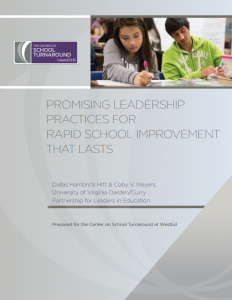Promising Leadership Practices for Rapid School Improvement That Lasts
Dallas Hambrick Hitt & Coby V. Meyers, University of Virginia Darden/Curry Partnership for Leaders in Education
Achieving rapid school improvement — most commonly referred to as “school turnaround” — is a complex undertaking. Equally challenging is the work of sustaining and even expanding on a school’s initial improvements so that the school can more fully become a vibrant learning organization.
There is much to learn from schools that demonstrate sustained improvement and those who lead them. But because there has not been a broad effort to identify and highlight such schools, their successes have heretofore yielded little practice-based guidance for other leaders who aspire to the same outcomes for the schools they lead. There is also much to learn from other fields, such as business, where research has focused on organizational turnaround.
This report, conceived to help fill a knowledge gap, presents promising practices for how to sustain the advances made in schools that have demonstrated rapid improvement. The promising practices presented here are derived from a comprehensive review of relevant literature, both within and beyond the field of education, and from the experience of five school principals who not only facilitated school turnaround but also catalyzed considerable ongoing growth in student achievement for at least four years following their school’s initial turnaround. The continued growth at these schools contrasts with the achievement plateaus or regressions that more commonly follow a school’s turnaround.
The five principals are often referred to herein as “leaders of sustained improvement” because, as that designation implies, they did not undertake this essential work alone. Their most important contribution may have been that they clearly ascertained the realms needing
attention and then prompted and supported positive contributions from others in order to collectively pursue improved outcomes for students.
At the school level, principals and leadership teams can use these promising practices to guide their teacher- and community-directed efforts and also to guide reflection on their own practices and their specific actions related to the practices. At the district level, principal supervisors can use them to design their support and coaching efforts. Superintendents or other district leaders can consider how to build the structures and interactions that are needed in order to enact these practices and related actions in district schools. For their part, state education agency (SEA) staff can consider these practices in thinking about how to encourage local education agencies to better support principals and schools.

